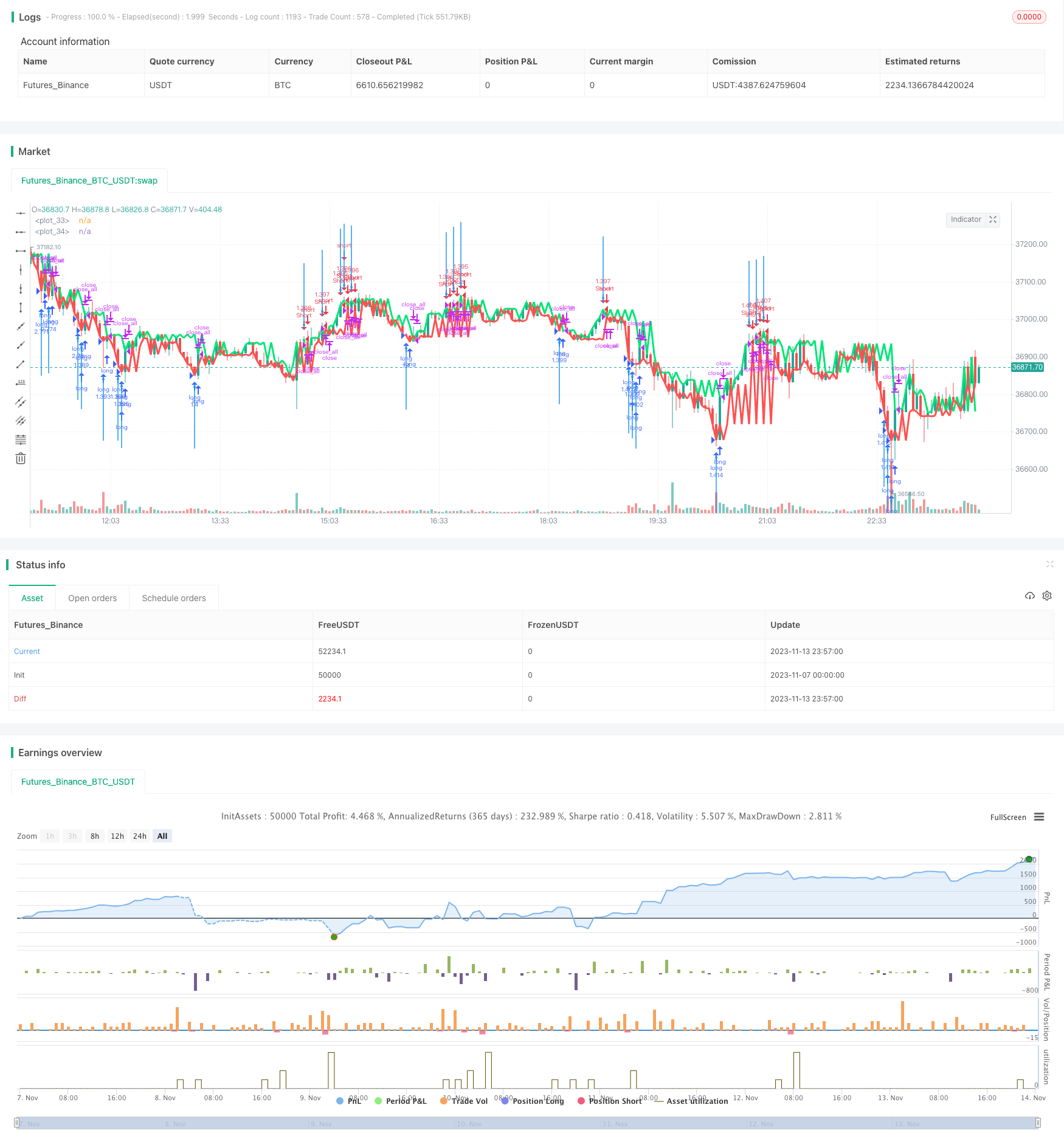
概述
该策略基于移动止损的思想,利用Distance Close Bars(DCB)指标判断价格走势,结合快速RSI指标进行过滤,实现移动止损和跟踪止损。策略同时还使用了马丁格尔增仓原理,适合中长线趋势交易。
原理
计算lastg和lastr分别代表最后一个涨幅K线的收盘价和最后一个跌幅K线的收盘价。
计算dist为lastg和lastr的价差。
计算adist为dist的30周期简单移动平均。
当dist大于adist的两倍时生成交易信号。
结合快速RSI指标过滤 signal,避免假突破。
若有信号且无持仓,按固定百分比入场开仓。
使用马丁格尔原理,亏损后加仓。
价格触发止损或止盈后平仓。
优势
采用DCB指标判断趋势方向,能够有效捕捉中长线趋势。
快速RSI指标过滤可避免假突破带来亏损。
移动止损止盈机制可锁定盈利,有效控制风险。
马丁格尔原理可在亏损后加大仓位,追求更高收益。
策略参数设置合理,适合不同市场环境。
风险
DCB指标可能发出错误信号,需要结合其他指标过滤。
马丁格尔加仓会加剧亏损,需要严格的资金管理。
止损点设置不合理可能造成超过预期的损失。
需要严格控制仓位数量,避免超出资金负担能力。
交易合约设置不当可能导致极端行情下巨额亏损。
优化思路
优化DCB参数,寻找最佳参数组合。
尝试其他指标替代快速RSI进行过滤。
优化止损止盈参数,提高策略胜率。
优化马丁格尔参数,降低加仓风险。
测试不同交易品种,选择最佳品种套利。
结合机器学习等技术动态优化策略参数。
总结
该策略 Overall是一个较为成熟的趋势跟踪策略。采用DCB判定趋势方向,快速RSI过滤信号可避免错误开仓。同时止损止盈机制可有效控制单笔亏损。但策略也存在一定风险,需要进一步优化参数以降低风险,提升稳定性。总体来说,该策略思路清晰易懂,适合中长线趋势交易者。
策略源码
/*backtest
start: 2023-11-07 00:00:00
end: 2023-11-14 00:00:00
period: 3m
basePeriod: 1m
exchanges: [{"eid":"Futures_Binance","currency":"BTC_USDT"}]
*/
//Noro
//2018
//@version=2
strategy(title = "Noro's Distance Strategy v1.0", shorttitle = "Distance str 1.0", overlay = true, default_qty_type = strategy.percent_of_equity, default_qty_value = 100, pyramiding = 10)
//Settings
needlong = input(true, defval = true, title = "Long")
needshort = input(true, defval = true, title = "Short")
usemar = input(true, defval = true, title = "Use Martingale")
capital = input(100, defval = 100, minval = 1, maxval = 10000, title = "Capital, %")
usersi = input(true, defval = true, title = "Use RSI-Filter")
periodrsi = input(7, defval = 7, minval = 2, maxval = 50, title = "RSI Period")
limitrsi = input(30, defval = 30, minval = 1, maxval = 50, title = "RSI Limit")
fromyear = input(2018, defval = 2018, minval = 1900, maxval = 2100, title = "From Year")
toyear = input(2100, defval = 2100, minval = 1900, maxval = 2100, title = "To Year")
frommonth = input(01, defval = 01, minval = 01, maxval = 12, title = "From Month")
tomonth = input(12, defval = 12, minval = 01, maxval = 12, title = "To Month")
fromday = input(01, defval = 01, minval = 01, maxval = 31, title = "From day")
today = input(31, defval = 31, minval = 01, maxval = 31, title = "To day")
//Fast RSI
fastup = rma(max(change(close), 0), periodrsi)
fastdown = rma(-min(change(close), 0), periodrsi)
fastrsi = fastdown == 0 ? 100 : fastup == 0 ? 0 : 100 - (100 / (1 + fastup / fastdown))
//Distance
bar = close > open ? 1 : close < open ? -1 : 0
lastg = bar == 1 ? close : lastg[1]
lastr = bar == -1 ? close : lastr[1]
dist = lastg - lastr
adist = sma(dist, 30)
plot(lastg, linewidth = 3, color = lime)
plot(lastr, linewidth = 3, color = red)
up = bar == -1 and dist > adist * 2
dn = bar == 1 and dist > adist * 2
//RSI Filter
rsidn = fastrsi < limitrsi or usersi == false
rsiup = fastrsi > 100 - limitrsi or usersi == false
//Signals
up1 = up and rsidn
dn1 = dn and rsiup
exit = ((strategy.position_size > 0 and close > open) or (strategy.position_size < 0 and close < open))
//Arrows
plotarrow(up1 ? 1 : na, colorup = blue, colordown = blue)
plotarrow(dn1 ? -1 : na, colorup = blue, colordown = blue)
//Trading
profit = exit ? ((strategy.position_size > 0 and close > strategy.position_avg_price) or (strategy.position_size < 0 and close < strategy.position_avg_price)) ? 1 : -1 : profit[1]
mult = usemar ? exit ? profit == -1 ? mult[1] * 2 : 1 : mult[1] : 1
lot = strategy.position_size == 0 ? strategy.equity / close * capital / 100 * mult : lot[1]
signalup = up1
if signalup
if strategy.position_size < 0
strategy.close_all()
strategy.entry("long", strategy.long, needlong == false ? 0 : lot, when=(time > timestamp(fromyear, frommonth, fromday, 00, 00) and time < timestamp(toyear, tomonth, today, 23, 59)))
signaldn = dn1
if signaldn
if strategy.position_size > 0
strategy.close_all()
strategy.entry("Short", strategy.short, needshort == false ? 0 : lot, when=(time > timestamp(fromyear, frommonth, fromday, 00, 00) and time < timestamp(toyear, tomonth, today, 23, 59)))
if time > timestamp(toyear, tomonth, today, 23, 59) or exit
strategy.close_all()